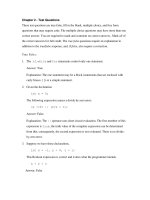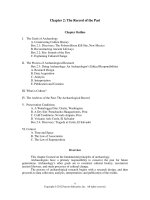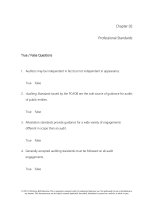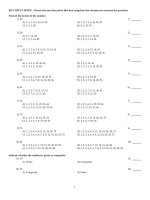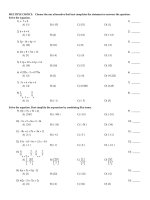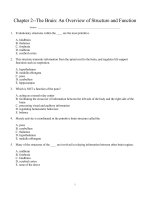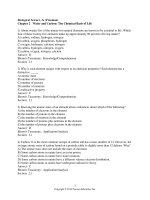Entrepreneurship successfully launching new ventures 5th edition barringer test bank
Bạn đang xem bản rút gọn của tài liệu. Xem và tải ngay bản đầy đủ của tài liệu tại đây (308.06 KB, 22 trang )
Entrepreneurship: Successfully Launching New Ventures, 5e (Barringer/Ireland)
Chapter 2 Recognizing Opportunities and Generating Ideas
1) iCracked, the company profiled in the opening feature of Chapter 2, was started by AJ
Forsythe and Anthony Martin, two California college students. Through personal experiences,
the two discovered that an opportunity existed to start a company that would ________.
A) repair computer printers inexpensively and conveniently
B) repair used automobiles inexpensively and conveniently
C) repair broken items (e.g., furniture and appliances) in college dorm rooms and apartments
inexpensively and conveniently
D) repair laptop computers inexpensively and conveniently
E) repair iPhones inexpensively and conveniently
Answer: E
Diff: 2 Page Ref: 41
LO: 2.1: Explain the difference between opportunities and ideas.
AACSB: Analytical Thinking
2) A(n) ________ is a favorable set of circumstances that creates a need for a new product,
service, or business.
A) idea
B) scheme
C) design
D) proposal
E) opportunity
Answer: E
Diff: 1
Page Ref: 43
LO: 2.1: Explain the difference between opportunities and ideas.
AACSB: Reflective Thinking
3) According to the textbook, opportunities are ________.
A) easy to spot
B) easy to spot in fast growing industries, but tough to spot in slow growing industries
C) easy to spot in the manufacturing sector, but tough to spot in the service sector
D) tough to spot
E) neither easy nor tough to spot
Answer: D
Diff: 2
Page Ref: 43
LO: 2.1: Explain the difference between opportunities and ideas.
AACSB: Reflective Thinking
1
Copyright © 2016 Pearson Education, Inc.
4) An opportunity has the following four essential qualities ________.
A) attractive; timely; durable; and anchored in a product, service, or business that creates or adds
value for its buyer or end user
B) practical; opportune; appropriate; and anchored in a product, service, or business that is
efficient and effective
C) realistic; striking; timely; and anchored in a product, service, or business that is timely
D) attention-getting; attractive; timely; and anchored in a product, service, or business that
creates or adds value for its buyer or end user
E) attractive, durable, resilient, and opportune
Answer: A
Diff: 2
Page Ref: 43
LO: 2.1: Explain the difference between opportunities and ideas.
AACSB: Reflective Thinking
5) Brad Johnson is starting an upscale men's clothing store in a mall near Seattle. He wants to
open his store during the time period in which a business like his can realistically enter the new
market. Brad is trying to open his business while the ________ is open.
A) safe harbor
B) window of opportunity
C) portal of entry
D) doorway of opportunity
E) safety zone
Answer: B
Diff: 2
Page Ref: 43
LO: 2.1: Explain the difference between opportunities and ideas.
AACSB: Reflective Thinking
6) The term "window of opportunity," as discussed in Chapter 2, is a metaphor that describes the
time period in which a firm can ________.
A) obtain funding or financing
B) hire new employees
C) complete a financial analysis
D) realistically enter a new market
E) write a business plan
Answer: D
Diff: 2
Page Ref: 43
LO: 2.1: Explain the difference between opportunities and ideas.
AACSB: Reflective Thinking
2
Copyright © 2016 Pearson Education, Inc.
7) Which of the following is correct regarding opportunities and ideas?
A) An opportunity and an idea are essentially the same thing.
B) An idea almost always meets the criteria of an opportunity.
C) An opportunity is a thought, an impression, or a notion.
D) An idea is a favorable set of circumstances that creates a need for a new product, service, or
business.
E) It's important to discern whether a particular idea meets the criteria for an opportunity.
Answer: E
Diff: 2
Page Ref: 44
LO: 2.1: Explain the difference between opportunities and ideas.
AACSB: Analytical Thinking
8) A(n) ________ is a favorable set of circumstances that creates the need for a new product,
service, or business. A(n) ________ is a thought, an impression or a notion.
A) scheme, notion
B) opportunity, idea
C) idea, design
D) idea, opportunity
E) notion, scheme
Answer: B
Diff: 1
Page Ref: 44
LO: 2.1: Explain the difference between opportunities and ideas.
AACSB: Reflective Thinking
9) Jessica Smith is thinking about starting a chain of fitness centers for young adults ages 18-30.
Which of the following is not an appropriate criterion for Jessica to test her idea against?
A) Determine whether the "window of opportunity" is open.
B) Determine whether a fitness center for young adults ages 18-30 meets the threshold of being a
good idea.
C) Determine the extent to which the notion takes advantage of an environmental trend, solves a
problem, or fills a gap in the marketplace.
D) Determine whether opening a fitness center for young adults ages 18-30 is timely.
E) Determine whether opening a fitness center for young adults ages 18-30 is a concept that
creates value for its buyer or end user.
Answer: B
Diff: 2
Page Ref: 44
LO: 2.1: Explain the difference between opportunities and ideas.
AACSB: Reflective Thinking
10) An idea is a favorable set of circumstances that creates a need for a new product, service, or
business.
Answer: FALSE
Diff: 1
Page Ref: 43
LO: 2.1: Explain the difference between opportunities and ideas.
AACSB: Reflective Thinking
3
Copyright © 2016 Pearson Education, Inc.
11) An opportunity has four essential qualities. It is (1) rare, (2) attractive, (3) timely, and (4)
anchored in a product, service, or business that creates or adds value for its buyer or end user.
Answer: TRUE
Diff: 2
Page Ref: 43
LO: 2.1: Explain the difference between opportunities and ideas.
AACSB: Analytical Thinking
12) The term "window of opportunity" is a metaphor describing the time period in which a firm
can realistically raise money.
Answer: FALSE
Diff: 2
Page Ref: 43
LO: 2.1: Explain the difference between opportunities and ideas.
AACSB: Reflective Thinking
13) An idea is a thought, impression, or notion. It may or may not meet the criteria of an
opportunity.
Answer: TRUE
Diff: 1
Page Ref: 43
LO: 2.1: Explain the difference between opportunities and ideas.
AACSB: Reflective Thinking
14) Describe the difference between an idea and an opportunity. Why is the distinction
important?
Answer: An opportunity is a favorable set of circumstances that creates a need for a new
product, service, or business. An opportunity has four essential qualities. It is (1) attractive, (2)
durable, (3) timely, and (4) is anchored in a product, service, or business that creates or adds
value for its buyer or end user. In contrast, an idea is a thought, impression, or notion. It may or
may not meet the criteria of an opportunity. This distinction between an idea and an opportunity
is important because many entrepreneurial ventures fail not because the entrepreneurs that
launched them didn't work hard, but rather because there was no real opportunity to begin with.
Diff: 1
Page Ref: 43
LO: 2.1: Explain the difference between opportunities and ideas.
AACSB: Analytical Thinking
15) The three ways to identify an opportunity include ________.
A) observing trends, solving a problem, and finding gaps in the marketplace
B) studying industry trade journals, talking to consumers, and solving a problem
C) observing trends, conducting brainstorming sessions, and studying industry trade journals
D) observing trends, talking to consumers, and finding gaps in the marketplace
E) reading books, solving a problem, and findings gaps in the marketplace
Answer: A
Diff: 2
Page Ref: 44
LO: 2.2: Describe the three general approaches entrepreneurs use to identify opportunities.
AACSB: Reflective Thinking
4
Copyright © 2016 Pearson Education, Inc.
16) GasBuddy and GasPriceWatch.com are companies started to help consumers save money on
gas. Which environmental trend is most likely to have provided the impetus for the creation of
these companies?
A) Regulatory changes
B) Political changes
C) Economic forces
D) Technological advances
E) Social forces
Answer: C
Diff: 2
Page Ref: 46
LO: 2.2: Describe the three general approaches entrepreneurs use to identify opportunities.
AACSB: Analytical Thinking
17) Economic forces impact the opportunities available to entrepreneurs. Which of the following
alternatives reflects a set of economic forces that would be of interest to entrepreneurs?
A) Level of disposable income, new uses of old technologies, and new laws and regulations
B) New technologies, consumer spending patterns, and new laws
C) Interest rates, consumer spending patterns, and level of disposable income
D) Social and cultural trends, level of interest rates, and what people think is "in"
E) New changes in political areas, new laws, and level of disposable income
Answer: C
Diff: 2
Page Ref: 46
LO: 2.2: Describe the three general approaches entrepreneurs use to identify opportunities.
AACSB: Reflective Thinking
18) Which of the following is not an example of a social force?
A) Changes in interest rates
B) Increasing participation in social networks
C) Increasing diversity of the workplace
D) Aging of the population
E) Continual migration of people from small towns and rural areas to cities
Answer: A
Diff: 2
Page Ref: 47
LO: 2.2: Describe the three general approaches entrepreneurs use to identify opportunities.
AACSB: Reflective Thinking
5
Copyright © 2016 Pearson Education, Inc.
19) An increased focus on health and wellness has resulted in a number of new business ideas
including healthier foods and beverages, yoga instruction and training centers, and nutrition
consulting. An increased focus on health and wellness is an important ________ that is creating
opportunities in many areas for entrepreneurial firms.
A) economic force
B) regulatory force
C) legal force
D) technological advances
E) social force
Answer: E
Diff: 2
Page Ref: 47
LO: 2.2: Describe the three general approaches entrepreneurs use to identify opportunities.
AACSB: Reflective Thinking
20) The increasing number of social networks on the Internet is attributed to a jump in the
number of people who are wanting to connect with one another online. The increasing number of
social networks is an important ________ trend.
A) political
B) economic
C) legal
D) social
E) demographic
Answer: D
Diff: 2
Page Ref: 47
LO: 2.2: Describe the three general approaches entrepreneurs use to identify opportunities.
AACSB: Reflective Thinking
21) Hulu.com allows people to watch television shows and movies on the Internet. Hulu.com's
business opportunity was made possible by ________ that enhanced the ability of television
shows and movies to be uploaded to the Internet and played by anyone with a suitable computer
and an Internet connection.
A) social forces
B) technological advances
C) legal changes
D) regulatory changes
E) economic forces
Answer: B
Diff: 2
Page Ref: 47
LO: 2.2: Describe the three general approaches entrepreneurs use to identify opportunities.
AACSB: Reflective Thinking
6
Copyright © 2016 Pearson Education, Inc.
22) If a new firm was launched to help businesses comply with The Affordable Care Act, that
opportunity was created by ________.
A) changes in economic forces
B) demographic changes
C) changes in social forces
D) changes in technological forces
E) political actions and regulatory changes
Answer: E
Diff: 2
Page Ref: 48
LO: 2.2: Describe the three general approaches entrepreneurs use to identify opportunities.
AACSB: Reflective Thinking
23) SafetyWeb is a Web-based service that helps parents protect their children's online
reputation, privacy, and safety. Which of the following approaches to identifying an opportunity
was most likely the impetus for SafetyWeb?
A) Observing trends
B) Studying government reports
C) Finding gaps in the marketplace
D) Talking to consumers
E) Solving a problem
Answer: E
Diff: 2
Page Ref: 50
LO: 2.2: Describe the three general approaches entrepreneurs use to identify opportunities.
AACSB: Reflective Thinking
24) The Savvy Entrepreneurial Firm feature in Chapter 2 focuses on a technique through which
entrepreneurs can learn about emerging trends. The technique focused on in the chapter is
________.
A) online databases
B) newspapers and magazines
C) targeted Internet searches
D) social media
E) radio and television
Answer: D
Diff: 2
Page Ref: 50
LO: 2.2: Describe the three general approaches entrepreneurs use to identify opportunities.
AACSB: Analytical Thinking
7
Copyright © 2016 Pearson Education, Inc.
25) Casey Griggs is a very capable computer engineer. Recently, he noticed a problem that
computer engineers have, and thought of a solution to the problem that might represent an
opportunity for a new software product. Casey's idea for a new software product is an example of
a(n) ________ discovery.
A) chance
B) serendipitous
C) traditional
D) conventional
E) opportune
Answer: B
Diff: 2
Page Ref: 50
LO: 2.2: Describe the three general approaches entrepreneurs use to identify opportunities.
AACSB: Reflective Thinking
26) Clothing boutiques and specialty shops often start because there is a need for a particular
product, but large retailers like Wal-Mart and Costco can't sell enough of the item to stock it on
their shelves. If a clothing boutique started to sell designer clothes or clothing for hard-to-fit
people because the clothing wasn't being offered by a larger retailer, the best way to describe
how that idea was recognized is ________.
A) finding a gap in the marketplace
B) brainstorming
C) observing trends
D) solving a problem
E) talking to consumers
Answer: A
Diff: 3
Page Ref: 53
LO: 2.2: Describe the three general approaches entrepreneurs use to identify opportunities.
AACSB: Reflective Thinking
27) In 2000, Tish Cirovolo realized that there were no guitars on the market made specifically
for women. As a result, she started Daisy Rock Guitars, a company that makes guitars just for
women. Daisy Rock Guitars are stylish and come in feminine colors, and incorporate design
features that accommodate a woman's smaller hand and build. The best way to describe how
Cirovolo's business idea was recognized is ________.
A) brainstorming
B) talking to consumers
C) reading industry reports
D) observing trends
E) finding a gap in the marketplace
Answer: E
Diff: 3
Page Ref: 53
LO: 2.2: Describe the three general approaches entrepreneurs use to identify opportunities.
AACSB: Reflective Thinking
8
Copyright © 2016 Pearson Education, Inc.
28) A common way that gaps in the marketplace are recognized is ________.
A) by observing changing environmental trends
B) by recognizing problems that need to be solved
C) via studying industry reports
D) when people become frustrated because they can't find a product or service that they need and
recognize that other people feel the same way
E) via combined focus groups and brainstorming sessions
Answer: D
Diff: 1
Page Ref: 53
LO: 2.2: Describe the three general approaches entrepreneurs use to identify opportunities.
AACSB: Reflective Thinking
29) The three ways to identify an opportunity include observing trends, solving a problem, and
finding gaps in the marketplace.
Answer: TRUE
Diff: 2
Page Ref: 44
LO: 2.2: Describe the three general approaches entrepreneurs use to identify opportunities.
AACSB: Reflective Thinking
30) Economic factors, social factors, technological advances, and political action and regulatory
changes are the most important trends to follow in trying to identify opportunities.
Answer: TRUE
Diff: 2
Page Ref: 44
LO: 2.2: Describe the three general approaches entrepreneurs use to identify opportunities.
AACSB: Reflective Thinking
31) Many new businesses are successful by taking advantage of fads.
Answer: FALSE
Diff: 2
Page Ref: 44
LO: 2.2: Describe the three general approaches entrepreneurs use to identify opportunities.
AACSB: Reflective Thinking
32) Aging of the population, the increasing diversity of the workplace, and the continual
migration of people from small towns and rural areas to cities are important economic trends.
Answer: FALSE
Diff: 1
Page Ref: 45
LO: 2.2: Describe the three general approaches entrepreneurs use to identify opportunities.
AACSB: Reflective Thinking
9
Copyright © 2016 Pearson Education, Inc.
33) Describe the three separate ways that entrepreneurs identify new business, product, and
service opportunities?
Answer: The three ways that entrepreneurs identify new business, product, and service
opportunities are through observing trends, solving a problem, and finding gaps in the
marketplace. The first approach to identifying opportunities is to observe trends and study how
they create opportunities to pursue. Economic forces, social factors, technological advances, and
political action and regulatory changes are the most important trends to follow. The second
approach to identifying opportunities is solving a problem. Sometimes identifying opportunities
simply involves noticing a problem and finding a way to solve it. These problems can be
pinpointed through observing trends and through more simple means (e.g., intuition, serendipity,
or chance). The third approach is finding gaps in the marketplace. This approach is accomplished
by finding a need that customers have that is not being satisfied-by either large, established firms
or entrepreneurial ventures. Large retailers like Wal-Mart, Costco, and Home Depot compete
primarily on price by serving large groups of customers with similar needs. They do this by
offering the most popular items targeted towards mainstream consumers. While this approach
allows the large retailers to achieve economies of scale, it leaves gaps in the marketplace.
Entrepreneurs step in to start businesses to fill these gaps. There are also gaps in the marketplace
that represent consumer needs that aren't being met by anyone.
Diff: 2
Page Ref: 44
LO: 2.2: Describe the three general approaches entrepreneurs use to identify opportunities.
AACSB: Reflective Thinking
34) The What Wrong feature in Chapter 2 focuses on Everpix, a company that enabled users to
organize and store photos online in an innovative manner. Regrettably, Everpix failed.
According to the feature, Everpix's failure resulted from that fact that it's founders ________.
A) spent too much time and energy perfecting their service at the expense of building a business
B) spent too much time and energy raising money at the expense of perfecting their service
C) spent too much time networking at the expense of building a business
D) spent too much time marketing their product at the expense of perfecting their service
E) spent too much time analyzing their market at the expense of networking
Answer: A
Diff: 2
Page Ref: 55
LO: 2.3: Discuss the personal characteristics of entrepreneurs that contribute to their ability to
recognize business opportunities.
AACSB: Reflective Thinking
10
Copyright © 2016 Pearson Education, Inc.
35) Which of the following statements is incorrect regarding the personal characteristics of
entrepreneurs?
A) Some people think that entrepreneurs have a "sixth sense" that allows them to see
opportunities that others miss.
B) The extent and depth of an individual's social network affects opportunity recognition.
C) Several studies show that prior experience in an industry actually blinds an entrepreneur to
the recognition of new opportunities in the same industry.
D) Creativity is the process of generating novel or useful ideas.
E) The corridor principle states that once an entrepreneur starts a firm, he or she begins a journey
down a path where "corridors" leading to new venture opportunities become apparent.
Answer: C
Diff: 3
Page Ref: 55
LO: 2.3: Discuss the personal characteristics of entrepreneurs that contribute to their ability to
recognize business opportunities.
AACSB: Analytical Thinking
36) The ability to notice things without engaging in deliberate search is referred to as ________.
A) cognitive alertness
B) cognitive awareness
C) managerial alertness
D) entrepreneurial alertness
E) individual awareness
Answer: D
Diff: 2
Page Ref: 56
LO: 2.3: Discuss the personal characteristics of entrepreneurs that contribute to their ability to
recognize business opportunities.
AACSB: Reflective Thinking
37) Kelly Pryor, who has launched several successful entrepreneurial firms, seems to have a
"sixth sense" that allows him to see opportunities that others miss. Kelly's ability is referred to as
_________.
A) individual awareness
B) cognitive alertness
C) entrepreneurial alertness
D) individual readiness
E) cognitive readiness
Answer: C
Diff: 2
Page Ref: 56
LO: 2.3: Discuss the personal characteristics of entrepreneurs that contribute to their ability to
recognize business opportunities.
AACSB: Reflective Thinking
11
Copyright © 2016 Pearson Education, Inc.
38) Which of the following statements is incorrect in regard to entrepreneurial alertness?
A) The research findings on entrepreneurial alertness are conclusive.
B) Alertness is largely a learned skill.
C) People who have more knowledge of an area tend to be more alert to opportunities in that area
than others.
D) The term "entrepreneurial alertness" is often associated with a "sixth sense" that seems to
allow some people to see opportunities that others miss.
E) Entrepreneurial alertness is defined as the ability to notice things without engaging in
deliberate search.
Answer: A
Diff: 3
Page Ref: 56
LO: 2.3: Discuss the personal characteristics of entrepreneurs that contribute to their ability to
recognize business opportunities.
AACSB: Reflective Thinking
39) According to the textbook, research results over time consistently suggest that somewhere
between ________ percent of those who start businesses got their ideas through social contacts.
A) 10 and 20
B) 20 and 30
C) 30 and 40
D) 40 and 50
E) 50 and 60
Answer: D
Diff: 3
Page Ref: 57
LO: 2.3: Discuss the personal characteristics of entrepreneurs that contribute to their ability to
recognize business opportunities.
AACSB: Reflective Thinking
40) An individual who identifies a business idea on his or her own is referred to as a(n)
________ entrepreneur.
A) separate
B) functional
C) lone
D) individual
E) solo
Answer: E
Diff: 2
Page Ref: 57
LO: 2.3: Discuss the personal characteristics of entrepreneurs that contribute to their ability to
recognize business opportunities.
AACSB: Reflective Thinking
12
Copyright © 2016 Pearson Education, Inc.
41) A network entrepreneur is an individual who identifies his or her business idea ________.
A) on their own
B) through the assistance of a paid consultant
C) through social contacts
D) with one or more partners
E) through a business incubator program
Answer: C
Diff: 2
Page Ref: 57
LO: 2.3: Discuss the personal characteristics of entrepreneurs that contribute to their ability to
recognize business opportunities.
AACSB: Reflective Thinking
42) A solo entrepreneur is an individual who identified his or her business idea ________. A
network entrepreneur is an individual who identified his or her business idea ________.
A) through social contacts; on their own
B) through a business incubator program; through social contacts
C) on their own; through social contacts
D) through the assistance of a paid consultant; through social contacts
E) with one or more partners; on their own
Answer: C
Diff: 3
Page Ref: 57
LO: 2.3: Discuss the personal characteristics of entrepreneurs that contribute to their ability to
recognize business opportunities.
AACSB: Reflective Thinking
43) ________ relationships are characterized by frequent interactions that form between
coworkers, friends, and spouses.
A) Balanced
B) Weak-tie
C) Lateral-tie
D) Moderate-tie
E) Strong-tie
Answer: E
Diff: 2
Page Ref: 57
LO: 2.3: Discuss the personal characteristics of entrepreneurs that contribute to their ability to
recognize business opportunities.
AACSB: Reflective Thinking
13
Copyright © 2016 Pearson Education, Inc.
44) Most of Sarah's ideas come from interacting with coworkers, friends, her spouse, her parents,
and other people that share the same beliefs that she does. Sarah is getting most of her ideas
through ________ relationships.
A) weak-tie
B) horizontal-tie
C) strong-tie
D) multiple-tie
E) vertical-tie
Answer: C
Diff: 2
Page Ref: 57
LO: 2.3: Discuss the personal characteristics of entrepreneurs that contribute to their ability to
recognize business opportunities.
AACSB: Reflective Thinking
45) Alex has a number of casual acquaintances that he interacts with infrequently. The
relationships that Alex has with these people are referred to as ________ relationships.
A) strong-tie
B) moderate-tie
C) lateral-tie
D) weak-tie
E) multiple-tie
Answer: D
Diff: 2
Page Ref: 57
LO: 2.3: Discuss the personal characteristics of entrepreneurs that contribute to their ability to
recognize business opportunities.
AACSB: Reflective Thinking
46) According to research in this area, it is more likely that an entrepreneur will get a new
business idea through a ________ relationship than the alternatives.
A) weak-tie
B) moderate-tie
C) vertical-tie
D) lateral-tie
E) strong-tie
Answer: A
Diff: 2
Page Ref: 57
LO: 2.3: Discuss the personal characteristics of entrepreneurs that contribute to their ability to
recognize business opportunities.
AACSB: Reflective Thinking
14
Copyright © 2016 Pearson Education, Inc.
47) ________ is the process of generating a novel or useful idea.
A) Innovation
B) Imagining
C) Creativity
D) Visualization
E) Envisioning
Answer: C
Diff: 1
Page Ref: 57
LO: 2.3: Discuss the personal characteristics of entrepreneurs that contribute to their ability to
recognize business opportunities.
AACSB: Reflective Thinking
48) Which of the following represents the correct order of the five stages of the creative process?
A) Preparation, incubation, elaboration, insight, evaluation
B) Insight, preparation, incubation, elaboration, insight
C) Preparation, incubation, insight, evaluation, elaboration
D) Incubation, evaluation, insight, preparation, elaboration
E) Incubation, preparation, evaluation, elaboration, insight
Answer: C
Diff: 3
Page Ref: 57
LO: 2.3: Discuss the personal characteristics of entrepreneurs that contribute to their ability to
recognize business opportunities.
AACSB: Reflective Thinking
49) Macy is a very creative person. Often, when trying to generate a novel or useful idea, she
spends several days "mulling over" the idea, which is her way of thinking it through, at both the
conscious and unconscious level. The stage of the creative process that Macy is in while she is
mulling over an idea is referred to as ________.
A) preparation
B) insight
C) evaluation
D) elaboration
E) incubation
Answer: E
Diff: 2
Page Ref: 58
LO: 2.3: Discuss the personal characteristics of entrepreneurs that contribute to their ability to
recognize business opportunities.
AACSB: Reflective Thinking
15
Copyright © 2016 Pearson Education, Inc.
50) In the five-stage creative process, the flash of recognition, or what is sometimes referred to
as the "eureka" experience, occurs in the ________ stage.
A) insight
B) preparation
C) incubation
D) elaboration
E) evaluation
Answer: A
Diff: 2
Page Ref: 58
LO: 2.3: Discuss the personal characteristics of entrepreneurs that contribute to their ability to
recognize business opportunities.
AACSB: Reflective Thinking
51) In the five-stage creative process, the stage in which the creative idea is put into final form is
referred to as the ________ stage.
A) insight
B) preparation
C) incubation
D) elaboration
E) evaluation
Answer: D
Diff: 2
Page Ref: 58
LO: 2.3: Discuss the personal characteristics of entrepreneurs that contribute to their ability to
recognize business opportunities.
AACSB: Reflective Thinking
52) Several studies have shown that prior experience in an industry helps entrepreneurs
recognize business opportunities.
Answer: TRUE
Diff: 2
Page Ref: 56
LO: 2.3: Discuss the personal characteristics of entrepreneurs that contribute to their ability to
recognize business opportunities.
AACSB: Reflective Thinking
53) Opportunity recognition may be an innate skill or cognitive process.
Answer: TRUE
Diff: 2
Page Ref: 56
LO: 2.3: Discuss the personal characteristics of entrepreneurs that contribute to their ability to
recognize business opportunities.
AACSB: Reflective Thinking
16
Copyright © 2016 Pearson Education, Inc.
54) Weak-tie relationships are characterized by infrequent interaction and ties between casual
acquaintances.
Answer: TRUE
Diff: 2
Page Ref: 57
LO: 2.3: Discuss the personal characteristics of entrepreneurs that contribute to their ability to
recognize business opportunities.
AACSB: Reflective Thinking
55) It is more likely that an entrepreneur will get a new business idea through a strong-tie than a
weak-tie relationship.
Answer: FALSE
Diff: 3
Page Ref: 57
LO: 2.3: Discuss the personal characteristics of entrepreneurs that contribute to their ability to
recognize business opportunities.
AACSB: Reflective Thinking
56) The five stages of the creative process include preparation, incubation, insight, evaluation,
and elaboration.
Answer: TRUE
Diff: 3
Page Ref: 57
LO: 2.3: Discuss the personal characteristics of entrepreneurs that contribute to their ability to
recognize business opportunities.
AACSB: Reflective Thinking
57) Incubation is the stage of the creative process during which an idea is subjected to scrutiny
and analyzed for its viability.
Answer: FALSE
Diff: 2
Page Ref: 58
LO: 2.3: Discuss the personal characteristics of entrepreneurs that contribute to their ability to
recognize business opportunities.
AACSB: Reflective Thinking
58) Evaluation is the stage of the creative process during which the idea is put into its final form.
Answer: FALSE
Diff: 2
Page Ref: 58
LO: 2.3: Discuss the personal characteristics of entrepreneurs that contribute to their ability to
recognize business opportunities.
AACSB: Reflective Thinking
17
Copyright © 2016 Pearson Education, Inc.
59) Describe the difference between strong-tie and weak-tie relationships. Is it more likely that
an entrepreneur will get new ideas through strong-tie or weak-tie relationships?
Answer: Strong-tie relationships are characterized by frequent interaction and form between
coworkers, friends, and spouses. Weak-tie relationships are characterized by infrequent
interaction and form between casual acquaintances. According to research in this area, it is more
likely that an entrepreneur will get a new business idea through a weak-tie than a strong-tie
relationship because strong-tie relationships, which typically form between like-minded
individuals, tend to reinforce insights and ideas the individuals already have. Weak-tie
relationships, on the other hand, which form between casual acquaintances, are not as apt to be
between like-minded individuals, so one person may say something to another that sparks a
completely new idea.
Diff: 3
Page Ref: 57
LO: 2.3: Discuss the personal characteristics of entrepreneurs that contribute to their ability to
recognize business opportunities.
AACSB: Reflective Thinking
60) ________ is (are) used to generate a number of ideas quickly.
A) Insight groups
B) Competitive intelligence gatherings
C) Examination groups
D) Survey groups
E) Brainstorming
Answer: E
Diff: 1
Page Ref: 59
LO: 2.4: Identity and describe techniques entrepreneurs use to generate ideas.
AACSB: Reflective Thinking
61) Which of the following is not one of the rules for a formal brainstorming session?
A) No criticism is allowed.
B) The session moves quickly.
C) Freewheeling is encouraged.
D) Leapfrogging is encouraged.
E) The session is used for decision making.
Answer: E
Diff: 2
Page Ref: 59
LO: 2.4: Identity and describe techniques entrepreneurs use to generate ideas.
AACSB: Reflective Thinking
18
Copyright © 2016 Pearson Education, Inc.
62) The number one rule for a brainstorming session is ________.
A) no criticism is allowed
B) no freewheeling is allowed
C) no leapfrogging is allowed
D) no more than 10 people are allowed to participate
E) no wild or unrealistic ideas are allowed
Answer: A
Diff: 2
Page Ref: 59
LO: 2.4: Identity and describe techniques entrepreneurs use to generate ideas.
AACSB: Reflective Thinking
63) According to the textbook, a focus group is a gathering of 5 to 10 people who are selected
because ________.
A) they are most likely to purchase large amounts of the product or service being discussed
B) they responded to a self-selected opinion poll about the topic being discussed
C) of their relationship to the issue being discussed
D) they responded to a mail survey about the topic being discussed
E) they are spokespersons for the topic being discussed
Answer: C
Diff: 2
Page Ref: 60
LO: 2.4: Identity and describe techniques entrepreneurs use to generate ideas.
AACSB: Reflective Thinking
64) According to the textbook, the best approach to utilizing a library for entrepreneurshiprelated research is to ________.
A) discuss your general area of interest with a reference librarian
B) focus your efforts on studying newspapers and periodicals
C) focus your efforts on browsing through industry-related materials
D) discuss your general area of interest with other library patrons
E) focus your efforts on academic journals
Answer: A
Diff: 2
Page Ref: 61
LO: 2.4: Identity and describe techniques entrepreneurs use to generate ideas.
AACSB: Reflective Thinking
65) An example of a valuable library resource is IBISWorld, which is a(n) ________.
A) business publication
B) academic journal
C) Census Bureau publication
D) trade journal
E) database of industry-related information
Answer: E
Diff: 2
Page Ref: 61
LO: 2.4: Identity and describe techniques entrepreneurs use to generate ideas.
AACSB: Reflective Thinking
19
Copyright © 2016 Pearson Education, Inc.
66) To make sure that its customers are satisfied and to probe for new product ideas, Intuit
routinely sends employees to the facilities of their customers. This technique for generating new
business ideas is called ________.
A) brainstorming
B) day-in-the-life research
C) focus group
D) survey
E) customer advisory board
Answer: B
Diff: 2
Page Ref: 62
LO: 2.4: Identity and describe techniques entrepreneurs use to generate ideas.
AACSB: Reflective Thinking
67) Brainstorming is used to generate a number of ideas quickly.
Answer: TRUE
Diff: 2
Page Ref: 59
LO: 2.4: Identity and describe techniques entrepreneurs use to generate ideas.
AACSB: Reflective Thinking
68) Brainstorming sessions are designed to move slowly, so ideas can be presented and
evaluated.
Answer: FALSE
Diff: 3
Page Ref: 59
LO: 2.4: Identity and describe techniques entrepreneurs use to generate ideas.
AACSB: Reflective Thinking
69) Focus groups typically involve a group of people who are unfamiliar with a topic and are
brought together to respond to questions.
Answer: FALSE
Diff: 2
Page Ref: 60
LO: 2.4: Identity and describe techniques entrepreneurs use to generate ideas.
AACSB: Reflective Thinking
20
Copyright © 2016 Pearson Education, Inc.
70) Describe how brainstorming can help facilitate the generation of ideas, and outline the four
rules for conducting a brainstorming session.
Answer: Brainstorming is a technique that is used to generate a number of ideas quickly. Among
the purposes a brainstorming session could be used for include the generation of new business,
product, or service ideas. In a brainstorming session, the leader of the group of people is
instructed to come up with ideas-one person shares an idea, another person reacts to it, another
person reacts to the reaction, and so on. A flip chart is typically used to record all the ideas. A
productive session is freewheeling and lively. The main objective is to create an atmosphere of
enthusiasm and originality where lots of ideas are generated. The four strict rules of
brainstorming are as follows:
1. No criticism is allowed.
2. Freewheeling is encouraged—the more ideas, the better.
3. The session moves quickly, and nothing is permitted to slow down the pace.
4. Leapfrogging is encouraged. This means using one idea as a means of jumping forward
quickly to other ideas.
Diff: 2
Page Ref: 59
LO: 2.4: Identity and describe techniques entrepreneurs use to generate ideas.
AACSB: Reflective Thinking
71) Describe how library and Internet research can be used to generate new business ideas.
Answer: Library and Internet research are important tools for generating business ideas. A
natural tendency is to think that an idea should be chosen, the process of researching the idea
should then begin. This approach is too linear. Often, the best ideas emerge when the general
notion of an idea, like creating casual electronic games for adults, is merged with extensive
library and Internet research, which might provide insights into the best types of casual games to
create. The best approach to utilizing a library is to discuss your general area of interest with a
reference librarian, who can point you to useful resources, such as industry-specific magazines,
trade journals, and industry reports. Simply browsing through several issues of a trade journal
can spark new ideas. Internet research is also important. If you are starting from scratch, simply
typing "new business ideas" into Google or Yahoo! will produce links to newspaper and
magazine articles about the "hottest" and "latest" new business ideas. If you have a specific idea
in mind, a useful technique is to set up a Google e-mail alert using keywords that pertain to your
topic of interest The Internet can also be used for specific searches and to access blogs that
provide insightful information on almost any topic.
Diff: 2
Page Ref: 61
LO: 2.4: Identity and describe techniques entrepreneurs use to generate ideas.
AACSB: Reflective Thinking
21
Copyright © 2016 Pearson Education, Inc.
72) A(n) ________ is a physical or digital repository for storing ideas.
A) suggestion bank
B) idea depository
C) suggestion pool
D) idea bank
E) proposition pool
Answer: D
Diff: 1
Page Ref: 62
LO: 2.5: Discuss actions to take to encourage continuous development of new ideas in
entrepreneurial firms.
AACSB: Reflective Thinking
73) Which of the following is an example of how to encourage creativity at the organizational
level?
A) Maintain a "stiff" organizational culture with no room for different behaviors.
B) Elevate creativity's importance throughout the organization.
C) Pigeonhole employees; keep them in the same job for years.
D) Make no attempt to hire creative people.
E) Promote a mentality suggesting that the best solutions to all problems have already been
found.
Answer: B
Diff: 2
Page Ref: 62
LO: 2.5: Discuss actions to take to encourage continuous development of new ideas in
entrepreneurial firms.
AACSB: Reflective Thinking
74) An idea bank is a physical or digital repository for storing ideas.
Answer: TRUE
Diff: 1
Page Ref: 63
LO: 2.5: Discuss actions to take to encourage continuous development of new ideas in
entrepreneurial firms.
AACSB: Reflective Thinking
75) Creativity and innovation are almost identical concepts.
Answer: FALSE
Diff: 2
Page Ref: 63
LO: 2.5: Discuss actions to take to encourage continuous development of new ideas in
entrepreneurial firms.
AACSB: Reflective Thinking
22
Copyright © 2016 Pearson Education, Inc.
